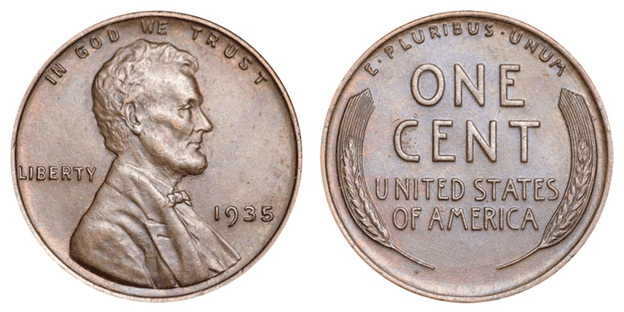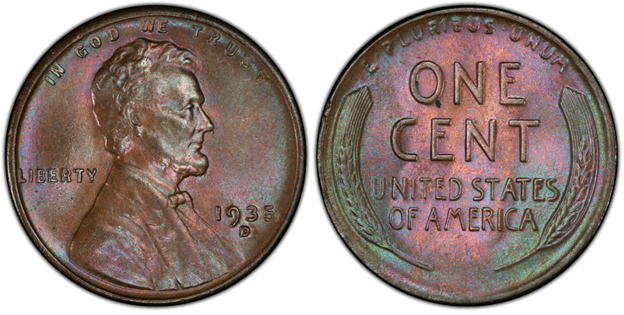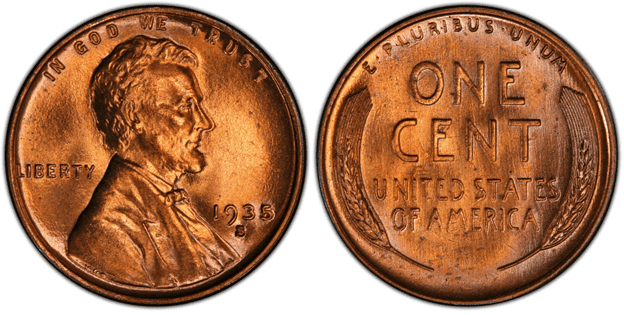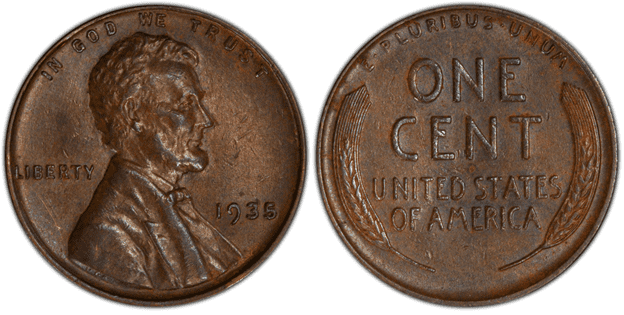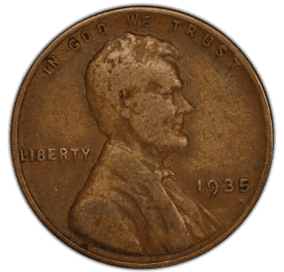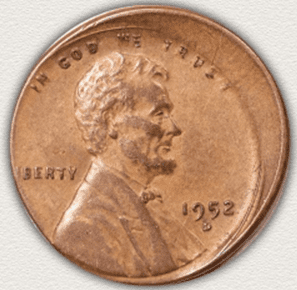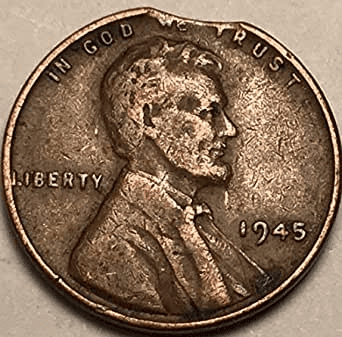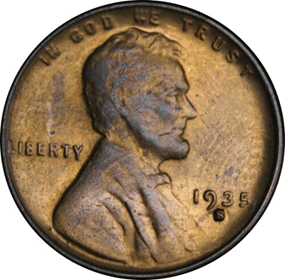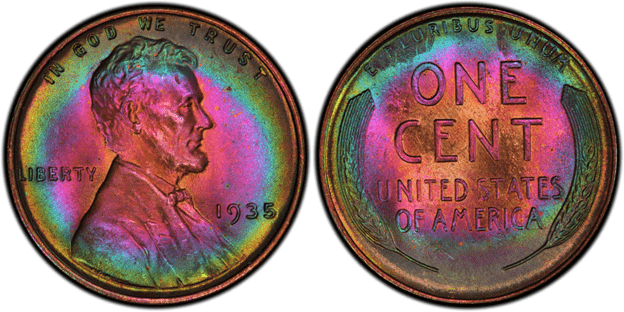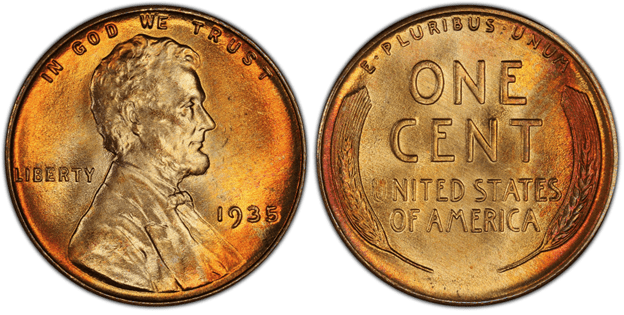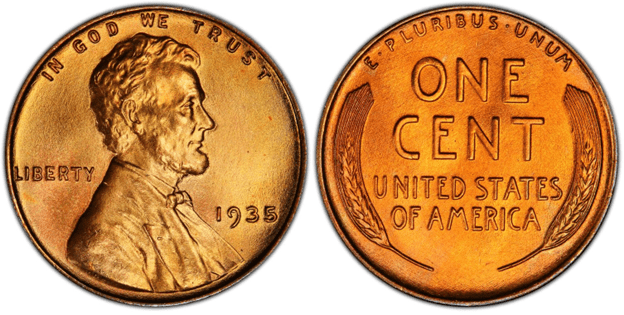What Makes A 1935 Wheat Penny Rare?
The 1935 Wheat Penny is an iconic iteration of the Lincoln Penny that makes a great starting place for budding collectors of US coinage.
The 1935 Lincoln penny’s obverse features a layout that is very similar to that of the current penny.
The image of President Abraham Lincoln is in the middle, surrounded by the words “Liberty” and the year of minting 1935, as well as two inscriptions. An elevated plaque that reads “In God We Trust” arches above.
The United States of America and “One Cent,” designating the face value, are written in two inscriptions on the reverse side’s middle portion.
There are solitary wheat stalks on either side of the main lettering. The nickname “Wheat Penny” for the coin comes from these wheat stalks. The Latin words “E Pluribus Unum” can then be seen arching above.
Based on the Victor Brenner design, the US Mint began making Lincoln pennies (also known as Wheat pennies or Wheaties) in 1909.
Theodore Roosevelt, who was president at the time, wanted to create a stunning coin to mark the 100th anniversary of Abraham Lincoln’s birth.
The Wheat Penny has a face value of 1 cent and is comprised of 95% copper and a 5% tin and zinc combination. It weighs 0.10970 ounces (3.11 g) and is 0.05984 inches (1.52 mm) thick, with a diameter of 0.74803 inches (19 mm). The edges of the coin are plain without reeding.
With an unemployment rate of more than 20%, the Great Depression was still going strong in the United States in 1935.
As Germany began to rearm and enacted the Nuremberg Laws, which denied Jews civil rights, the Second World War was rapidly approaching. The Boulder (Hoover) Dam was also built this year.
The China Clipper delivers the first piece of airmail across the region, bringing people closer together for the first time in history. Famous US aviator Amelia Earhart was the first woman to fly alone across the Pacific Ocean.
How Rare Is A 1935 Wheat Penny?
While the Wheat Penny doesn’t have a lot of metal value as it is comprised of mostly copper, the value of this coin largely comes from its rarity. 1935 is nearly 90 years ago, so as you’d imagine, coins from this era in uncirculated or higher quality condition are pretty scarce.
While not the rarest coin out there, a mint-quality Wheat Penny could certainly be considered the jewel in many collectors’ proverbial crowns. Other factors that can influence the rarity of a 1935 Wheat Penny include its patina and any errors present in the coin.
1935 Wheat Penny Varieties
1935 Wheat Penny With No Mint Mark
Year: 1935
Face Value: $0.01
Composition: 95% copper and a 5% tin/zinc combination
Total Weight: 3.11g
Diameter: 19 mm
Thickness: 1.52 mm
Edge: Plain
Minted in: Philadelphia
Quantity Minted: 245,388,000

photo source: www.usacoinbook.com
While you may think that a coin without a mint mark is exceptionally rare, it actually denotes one of the most common places that a coin can be struck; Philadelphia. If you didn’t already know, the mint mark is used to indicate where the coin was struck, such as ‘D’ for Denver.
The only exception to this rule is the mint at Philadelphia who’ve never placed a mint mark on the coins they’ve struck.
1935 D Wheat Penny
Year: 1935
Face Value: $0.01
Composition: 95% copper and a 5% tin/zinc combination
Total Weight: 3.11g
Diameter: 19 mm
Thickness: 1.52 mm
Edge: Plain
Minted in: Denver
Quantity Minted: 47,000,000

photo source: www.pcgs.com
1935 S Wheat Penny
Year: 1935
Face Value: $0.01
Composition: 95% copper and a 5% tin/zinc combination
Total Weight: 3.11g
Diameter: 19 mm
Thickness: 1.52 mm
Edge: Plain
Minted in: Denver
Quantity Minted: 38,702,000

photo source: www.pcgs.com
List of errors
1935 Doubled Die Wheat Penny

photo source: www.pcgs.com
When the hub stamps a design on the die (the device that stamps blank coins or planchets), it does so at two slightly different and separate angles, which is a sort of mistake known as a doubled die.
Each of the three 1935 cent series has a few documented instances with ascribed doubled dies:
- 1935 doubled die penny: The inscriptions on the obverse and Lincoln’s eye are noticeably duplicated on some 1935 Philadelphia Lincoln cents.
- 1935-D doubled die cent: Features doubling in E PLURIBUS UNUM on the reverse, making it one of the most striking examples.
- At least one specimen of the 1935-S doubled die wheat cent has doubling in the reverse inscriptions and the wheat ears.
Coins with doubled die errors can cost anywhere from $50 to $100 or more.
1935 Wheat Penny with Die Breaks

photo source: coins.ha.com
Die breaks happen when the coin die develops minor cracks that can range in size from being extremely small to covering the full coin’s face. In general, the coin is worth more the more dramatic the die break.
Die cracks often only affect one side of the coin and appear as elevated, straight or wavy lines.
- Die breaks that are small and minor are only worth $3 to $5.
- Die breaks that are spectacular are often worth more than $50 to $100.
Die breaks can happen on any sort of coin, but the so-called “BIE” defect that appears on Lincoln cents is a really uncommon variation. Between the “B” and “E” of “LIBERTY” on the obverse, there is a tiny vertical die fracture that resembles a capital “I” in BIE mistakes.
BIE faults come in various forms and sizes, and most have a value of $5 to $15.
1935 Wheat Penny with off-center Strike

photo source: www.coinstudy.com
When the planchet is not properly centered on the striking press or the die is not properly aligned, off-center mistakes happen. These faults can range in severity from minor to severe to anywhere in between.
- Less than 3 per cent off-center errors are quite frequent and don’t really warrant a premium.
- Prices increase dramatically from there for off-center errors that are 5 to 10 per cent or more off-center, with values starting at $5 to $10.
- The off-center faults that are far off but still display the complete date of the coin, such as the 1952 example presented above, are the most desirable; they can sell for up to $100.
1935 Wheat Penny Clipped Planchet

photo source: www.amazon.com
The planchet itself may get accidentally damaged if the planchet-cutting machine makes a mistake when cutting a blank. As a result, the coin may have a cut into the side that is roughly straight or curved as seen in the above 1945 example.
Depending on the amount and severity of the clip, values for clipped planchet faults might vary, but the majority are worth $10 and higher.
1935 Penny with Repunched Mint Mark

photo source: www.ebay.com
Mintmarks were hand-punched onto each active die on coins produced before the 1990s. There were occasional errors made with this technique because those mintmarks were manually punched onto the dies.
In certain instances, the first punch was delivered in the incorrect spot or skewed, hence a second punch was delivered to make up for the error.
Repunched mintmarks are among the most common variants of Lincoln penny errors, and their values typically range from $3 to $10, depending on how rare or collectable a given repunched mintmark variety is.
Penny Patinas
Not quite an error, but a unique factor of Lincoln Pennies with a high copper content is the patina or ‘tone’ they develop as they age.
Numismatics split these patinas into three categories with exceptional examples of some being worth far more than others.
The ‘BN’, or brown patina, is the most prevalent of the three; it has the appearance of being the oldest and is the color that copper coins normally take on over time.
In some specimens with this patina that have not been cycled very often, greenish or bluish hues, which are typical in this metal, can be seen, making it even more unique.
As you can see in the exceptional example below these color shifts can be pretty dynamic.

photo source: www.pcgs.com
The abbreviation “RB” stands for Red and Brown, indicating that the specimen is brown with the reddish tones typical of a freshly minted copper coin, similar to the patina that came before it.
Whether an RB has been infrequently circulated yet preserved in a humid environment, it is the consequence of superior environmental conservation, or at the very least less exposure to humidity and oxygen than the preceding one. Due to its rarity, it is, therefore, a little more expensive than the previous one.

photo source: www.pcgs.com
The red patina that copper coins get when they are originally struck is known as the “RD” patina; it is rare since it is difficult to preserve a coin with that tone for such a long time.
Collectors highly value this patina because it is the most expensive of the three. The most distinctive patinas are prioritized with coins this common, therefore a BN or RB may be depreciated, whereas an RD raises the coin’s value due to its rarity among common coins.
To maintain the original patina of a penny, it is essential to keep them in a stable and controlled atmosphere.

photo source: www.pcgs.com
How Much Is A 1935 Lincoln Wheat Penny Worth Today?
Due to its lack of precious metals, the 1935 Wheat Penny only has a melt value of $0.023. This is still doubled the face value of the coin, but an extra cent really isn’t worth much compared to its numismatic value.
The table below was curated by Coin Study and shows the average value for 1935 Wheat Pennies, though, of course, this chart doesn’t account for elements such as errors and patina previously discussed.
How Does The Grading System Work?
The Sheldon Scale is used by numismatists to provide a numerical value to coins. The Sheldon Scale goes from poor (P-1) to perfect mint state (P-1) (MS-70). Coins were originally evaluated using words to reflect their condition (Good, Fair, Excellent, Etc.). Unfortunately, coin collectors and dealers had different ideas about what each of these terms represent.
Professional numismatists joined together in the 1970s and established CoinGrading standards. These numismatists now assign grades at key places on the seventy-point scale, using the most regularly utilized numeric points in conjunction with the original adjective grade. The following are the most common coin grades:
-
-
- (P-1) Poor – Indistinguishable and probably damaged; if used, must have a date and mintmark; otherwise, rather battered.
- (FR-2) Fair – Nearly smooth, but without the damage that a coin graded Poor often possesses. The coin must have enough detail to be identified.
- (G-4) Fair – Inscriptions have merged into the rims in some areas, and important elements have been mostly erased.
- (VG-8) Very Good- A little weathered, but all of the primary design elements are visible, albeit faintly. There is little if any, central detail left.
- (F-12) Good – The item is very worn, yet the wear is even, and the overall design details stand out clearly. Rims are almost completely isolated from the field.
- (VF-20) Very Fine – Moderately weathered, with some finer features still visible. The motto or all letters of LIBERTY are readable. Both sides of the coin have entire rims that are separated from the field.
- (EF-40) Extremely Fine – Gently used; all gadgets are visible, and the most important ones are bold. The finer details are bold and clear, however, light wear may be seen.
- (AU-50) Uncirculated – Slight evidence of wear on the coin’s design’s high points; may have contact marks; eye appeal should be adequate.
- (AU-58) Uncirculated Choice – Slight traces of wear, no severe contact marks, almost full mint shine, and great eye appeal.
- (MS-60) Mint State Basal – Strictly uncirculated; no indication of wear on the coin’s highest points, but an unsightly coin with reduced luster, visible contact marks, hairlines, and other flaws.
- (MS-63) Mint State Acceptable – Uncirculated, but with contact scratches and nicks, little reduced shine, but otherwise appealing appearance. The strike is weak to average.
- (MS-65) Mint State Choice – Uncirculated with great mint shine, very little contact blemishes, and exceptional eye appeal. The strike is unusually severe.
- (MS-68) Mint State Premium Quality – Uncirculated with superb luster, no obvious contact marks to the naked eye, and exceptional eye appeal. The strike is quick and appealing.
- (MS-69) Almost Perfect Mint State – Uncirculated with perfect brilliance, a sharp and appealing strike, and extremely good eye appeal. A near-perfect coin with minor imperfections in the planchet, strike, and contact markings (seen only under 8x magnification).
- (MS-70) Mint State Perfect – Under 8x magnification, there are no tiny imperfections discernible; the strike is crisp, and the coin is perfectly centered on a beautiful planchet. Rarely seen on a coin, this coin is bright and whole, with original luster and exceptional eye appeal.
-
Where To Buy Or Sell 1935 Wheat Pennies?
As you can see by the mint numbers of this coin, the 1935 Wheat Penny is a fairly common coin and some lucky, keen-eyed individuals may even find one in their pocket change, as this is still technically legal tender.
As we mentioned at the start of this article, the 1935 Wheat Penny makes a great place for a budding collector to start, and therefore, the best option for buying and selling this coin is via online marketplaces like eBay and Etsy.
It’s even possible to find some pretty cool error examples of these coins on the aforementioned sites for not too much money.
Of course, any potentially rare examples of the 1935 Wheat Penny should be sold through specialist dealers after grading by a service such as PGCS.
If you’re unsure about the coin in your possession, there are lots of great coin-collecting forums which can help give you more information about what you’re looking at.
FAQs
Where is the mint mark on a 1935 wheat penny?
The mint mark on a 1935 Wheat Penny is found just below the date on the obverse side of the coin.
Are pennies without a mint mark valuable?
In US coins the lack of mint mark doesn’t indicate anything special and simply denotes that the coin was minted in Philadelphia. Coins struck here have never possessed a mint mark unlike coins struck in Denver which have a ‘D’ or San Francisco which has an ‘S’.
What year is the wheat penny most valuable?
The 1914 D Wheat Penny, which is regarded as the most expensive of the non-error Wheat Pennies, demands an asking price range from $281 and $4,268.

